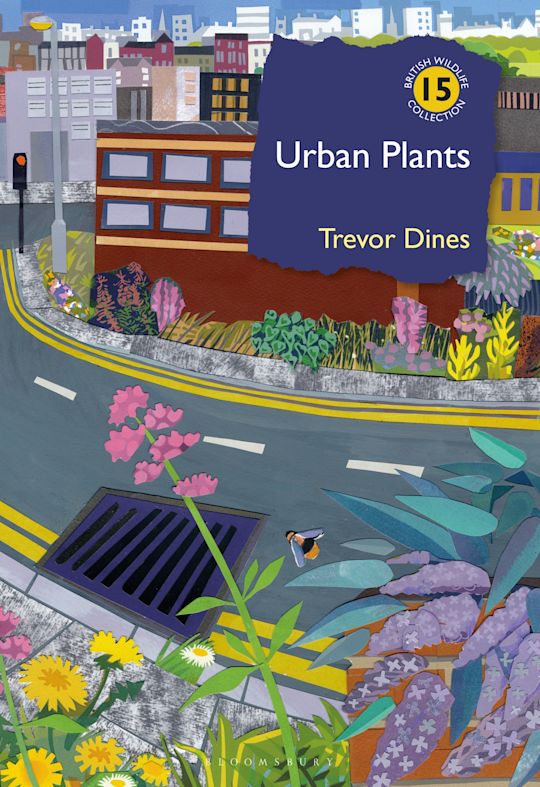Urban Plants is the latest (the 15th) in the British Wildlife Collection published by Bloomsbury. By chance it follows my own book in that series, Rare Plants, and so could seem like a companion volume, though in fact it is closer to being its mirror image. My book dealt with rare, mainly native, species in mostly rural settings. Trevor’s is about mainly introduced, mainly common, plants in towns and cities. And not so much about individual species (though of course there are many examples) as about plants in the round, or, as the blurb puts it, ‘a deep dive into the biology, ecology and cultural impact of the plants that set up home alongside us’.
The urban environment is in many ways a tough place for plants. Concrete and tarmac have little to offer as habitat, and the street plant must cope with pollutants, herbicides, droughts, roadworks, salt, and violent winds, not to mention periodic splashes from traffic on wet days. Yet, despite that, our cities now support more species than any comparable area of countryside. Greater London plays host to 3,569 species of vascular plant, two-thirds of which are neophytes or recent arrivals (the next richest cities are Cambridge, Sheffield and Glasgow, but probably because their flora is the best studied). Much of the excitement of latter-day plant recording comes from finding new and ever more exotic urban plants. You never know what you will find next (bananas in Piccadilly? Well, Japanese Banana is doing fine at Beckton in east London).
Trevor Dines has written an engaging personal book on the challenges and triumphs of urban plants based on long experience as a botanist and naturalist (he is the one who created #NoMowMay). He divides it into three main parts. The first explores the urban setting, defining what we mean by urban and by an urban flora, before exploring the various ways in which non-native flowers, ferns and mosses have arrived (gardens, bird seed, dumped rubbish, contaminated grain) and how they established themselves.
The second part takes a deeper look at the ecology of urban landscapes, which of course contain a surprisingly large proportion of open spaces as well as ‘encapsulated countryside’. Nearly half of Greater London is green. We learn about the characteristics of a successful urban plant, great splurgers of seed, or ones that emerge magically from fragments, or slip down roots into the tiniest cracks and joints. We explore the gradual conquest of manmade places from the first recorded wholly urban wild flower, London Rocket, which took over after the Great Fire of London in 1666, to the explosion of Rosebay Willowherb in bomb-damaged cities during the war, and so on to the creation of the urban jungles of today, colourful riots often led by that lovable rogue, Buddleia.
The third and longest part goes into the detail of urban habitats with separate chapters on pavements, walls, street trees, and what Dines calls ‘urban fallow’, that is waste ground, whose survival is likely to be temporary unless protected. The habitats may be artificial, but plants will be plants: they compete for space, often aggressively; their communities develop and change over time, and some even develop resistance to herbicides. Different cities have acquired their own, characteristic flora. In Birmingham you will see a lot of Canadian Goldenrod; in London and Sheffield an abundance of Goat’s-rue.
In a thoughtful final chapter, Dines asks whether conservation is the answer in the context of a dynamic and ever-changing habitat. A few species, such as London Rocket and the two endemic and endangered ragworts, certainly deserve protection. For the rest, perhaps what is needed most is a more tolerant attitude to ‘weeds’, or, in Dines’ perfect phrase, a ‘managed messiness’. There are hopeful signs of that, helped by the rising price and legal restrictions on herbicides.
As one has come to expect from this series, Urban Plants is well-written in a friendly, engaging way, and from a deep immersion in the subject. It is beautifully jacketed and designed and lusciously illustrated. However, I do have a couple of issues. When captioning bryophytes or lichens (or most invertebrates for that matter), I wish they would include the scientific names as most of us do not know the new-fangled English ones (tu quoque, I too am guilty of that in Rare Plants). More importantly, when he first designed the series, Andrew Branson was careful to ensure that the pages would fall open and flat, for that greatly aids readability. This is no longer so, and the text currently runs too close to the spine so that we are forced to read it on the curve of the (glossy) paper. This might seem a minor point, but I hope that the editors are on to it.

